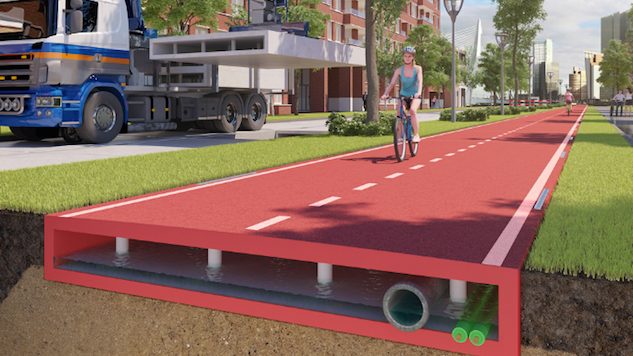Turning Toward Plastic Waste to Build a Greener Future

The best innovations are often those that set out to solve for a simple problem and end up accomplishing much more. So goes the story of PlasticRoad, a Netherlands-based initiative that recycles plastic waste into lightweight modules that link together, Lego style, to build out roads with a remarkably smaller ecological footprint than asphalt. Inventors Anne Koudstaal and Simon Jorritsma began developing PlasticRoad in 2016 with the support of KWS, a subsidiary of VolkerWessels.
PlasticRoad isn’t the only cool kid on the block. India mixes plastic into asphalt roads as a way of reducing waste and carbon emissions. France just rolled out the world’s first solar powered road. What makes this project unique, however, is its all-encompassing simplicity, which demonstrates five possibilities for creating a greener future.
A New Vision for Plastic Waste
PlasticRoad began as a response to the many problems intrinsic to asphalt infrastructure. Roads flood. Sediment builds. Cables and pipes clutter overhead space, while those routed below ground require major roadwork to be accessed and repaired. The inventors envisioned a material that realigns water and sediment flow, creates easier access for repairs, and is environmentally friendly.
 Image by Bo Eide
Image by Bo Eide
Where did they start? With the enemy. Plastic waste—the same stuff that clogs our oceans, pollutes our air and contributes directly to global warming—was repurposed into configurable, lightweight modules. Each 4.8 × 3.5 meter module uses approximately 600 kilos of plastic, or roughly 66,139 bottles.
“If you have a plastic bottle,” Koudstaal said, “you only use it for one hour and throw it away, and after that it’s going to be burned. It’s a waste of all the energy that’s put into the plastic bottle and the materials that are used to create it.” In other words, the choice of material solves for two problems at once: it offers a cleaner solution to asphalt, while decluttering the planet.
-

-

-

-

-

-

-

-

-

-

-

-

-

-

-

-

-

-

-

-

-

-

-

-

-

-

-

-

-

-

-

-

-

-

-

-

-

-

-

-








































